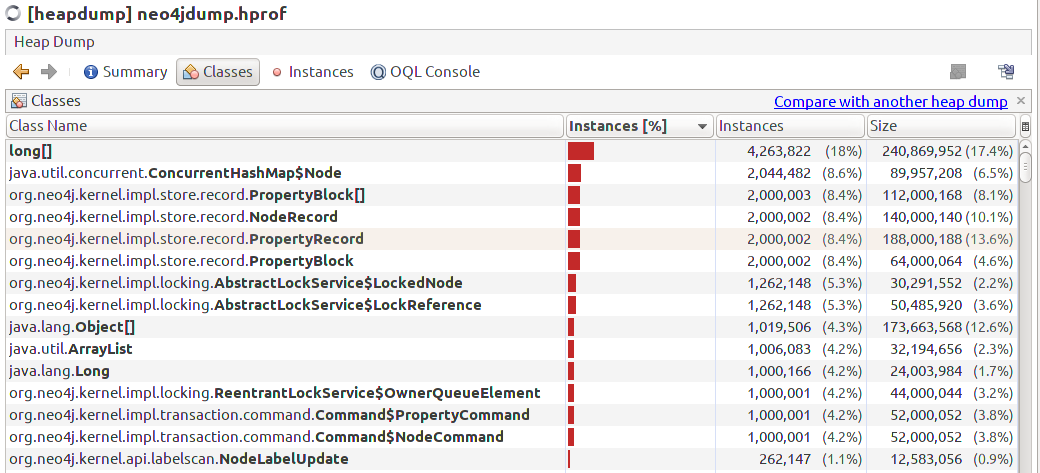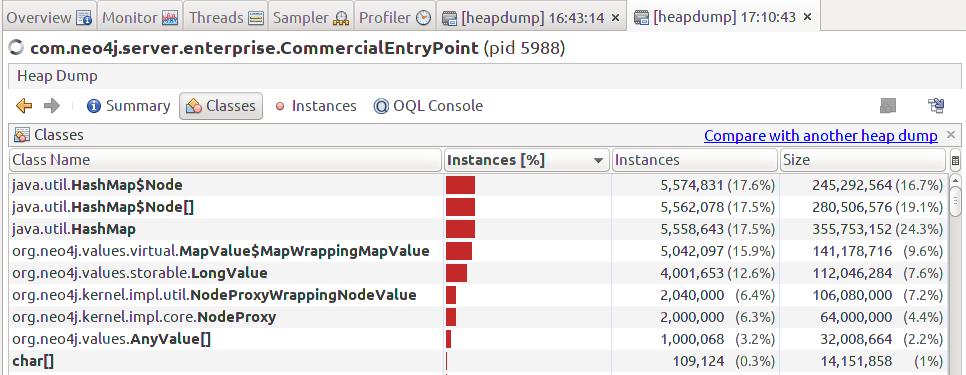Neo4j: Delete all nodes
When experimenting with a new database, at some stage we’ll probably want to delete all our data and start again. I was trying to do this with Neo4j over the weekend and it didn’t work as I expected, so I thought I’d write the lessons I learned.
We’ll be using Neo4j via the Neo4j Desktop with the default settings. This means that we have a maximum heap size of 1GB.
This blog post assumes that you’ve got the Neo4j APOC library installed. We can find instructions for installing that library in the docs.
Cypher Shell
In this post we’ll be executing Cypher queries using the Cypher Shell. We can launch that from the Neo4j Desktop like this:

Creating data
Once we’ve done that we’re ready to create 1 million nodes using APOC’s periodic iterate procedure.
neo4j> CALL apoc.periodic.iterate(
'UNWIND range(1, 1000000) as id RETURN id',
'CREATE (:Node {id: id})',
{}
)
YIELD timeTaken, operations
RETURN timeTaken, operations;
+-------------------------------------------------------------------------+
| timeTaken | operations |
+-------------------------------------------------------------------------+
| 8 | {total: 1000000, committed: 1000000, failed: 0, errors: {}} |
+-------------------------------------------------------------------------+
1 row available after 8249 ms, consumed after another 0 msLet’s check how many nodes our database contains:
neo4j> MATCH () RETURN count(*);
+----------+
| count(*) |
+----------+
| 1000000 |
+----------+
1 row available after 0 ms, consumed after another 0 msGreat, 1 million nodes, all ready to be deleted!
Deleting nodes
My first attempt to delete all this nodes was the following query, which finds all the nodes and then attempts to delete them:
neo4j> MATCH (n)
DETACH DELETE n;
There is not enough memory to perform the current task. Please try increasing 'dbms.memory.heap.max_size' in the neo4j configuration (normally in 'conf/neo4j.conf' or, if you you are using Neo4j Desktop, found through the user interface) or if you are running an embedded installation increase the heap by using '-Xmx' command line flag, and then restart the database.Hmmm, an OutOfMemory exception. I had some ideas as to why that might be happening, but it’s best to get a heap dump to know for sure.
We can add the following lines to the Neo4j settings or configuration file to create a heap dump when an OutOfMemory exception is thrown:
dbms.jvm.additional=-XX:+HeapDumpOnOutOfMemoryError -XX:HeapDumpPath=/tmp/neo4jdump.hprofIf you’re using the Neo4j Desktop, you can find this file from the 'Settings' tab:

We can visualise the contents of this file using a tool like YourKit or VisualVM. I have VisualVM installed on my machine, so we’ll use that. Below is a print screen showing the heap dump:

Many of the classes taking up space on the heap are used to create the commands that get stored in the transaction log whenever we execute a write query.
Batching deletes
We need to delete our nodes in batches so that we don’t end up with so much in memory state.
My go to procedure is apoc.periodic.iterate, so let’s give that a try:
CALL apoc.periodic.iterate(
'MATCH (n) RETURN n',
'DELETE n',
{batchSize: 10000}
)
YIELD timeTaken, operations
RETURN timeTaken, operationsI found that sometimes this works, but sometimes we end up with the whole heap being filled, and a lot of garbage collection pauses:

We can also see all the GC pauses by searching the debug log, which we can access via the 'Terminal' tab:
$ grep VmPauseMonitorComponent logs/debug.log | tail -n 10
2019-04-14 16:14:22.377+0000 WARN [o.n.k.i.c.VmPauseMonitorComponent] Detected VM stop-the-world pause: {pauseTime=9143, gcTime=4619, gcCount=7}
2019-04-14 16:14:28.845+0000 WARN [o.n.k.i.c.VmPauseMonitorComponent] Detected VM stop-the-world pause: {pauseTime=6367, gcTime=6451, gcCount=10}
2019-04-14 16:14:35.730+0000 WARN [o.n.k.i.c.VmPauseMonitorComponent] Detected VM stop-the-world pause: {pauseTime=2131, gcTime=6875, gcCount=12}
2019-04-14 16:14:44.455+0000 WARN [o.n.k.i.c.VmPauseMonitorComponent] Detected VM stop-the-world pause: {pauseTime=9080, gcTime=4523, gcCount=5}
2019-04-14 16:14:46.721+0000 WARN [o.n.k.i.c.VmPauseMonitorComponent] Detected VM stop-the-world pause: {pauseTime=6364, gcTime=6449, gcCount=18}
2019-04-14 16:15:09.106+0000 WARN [o.n.k.i.c.VmPauseMonitorComponent] Detected VM stop-the-world pause: {pauseTime=19938, gcTime=22355, gcCount=28}
2019-04-14 16:15:13.288+0000 WARN [o.n.k.i.c.VmPauseMonitorComponent] Detected VM stop-the-world pause: {pauseTime=6428, gcTime=4176, gcCount=7}
2019-04-14 16:15:17.807+0000 WARN [o.n.k.i.c.VmPauseMonitorComponent] Detected VM stop-the-world pause: {pauseTime=4418, gcTime=4515, gcCount=5}
2019-04-14 16:16:00.108+0000 WARN [o.n.k.i.c.VmPauseMonitorComponent] Detected VM stop-the-world pause: {pauseTime=19724, gcTime=42279, gcCount=40}
2019-04-14 16:16:00.209+0000 WARN [o.n.k.i.c.VmPauseMonitorComponent] Detected VM stop-the-world pause: {pauseTime=22476, gcTime=10, gcCount=1}If we take a heap dump using VisualVM, we’ll see something like this:

This time it’s not commands that are taking up the space, but rather objects holding all the nodes that we want to delete.
To avoid loading all those nodes into memory, we can use the apoc.periodic.commit procedure instead.
With this procedure we provide one query that must contain a LIMIT clause.
We also need to include a RETURN clause at the end of our query, and as long as a result is returned, it will keep on iterating.
neo4j> CALL apoc.periodic.commit(
'MATCH (n) WITH n LIMIT $limit DELETE n RETURN count(*)',
{limit: 10000}
)
YIELD updates, executions, runtime, batches
RETURN updates, executions, runtime, batches;
+------------------------------------------+
| updates | executions | runtime | batches |
+------------------------------------------+
| 1000000 | 100 | 7 | 101 |
+------------------------------------------+
1 row available after 7540 ms, consumed after another 0 msGood times! All the nodes are deleted and we can get on with our day.
About the author
I'm currently working on short form content at ClickHouse. I publish short 5 minute videos showing how to solve data problems on YouTube @LearnDataWithMark. I previously worked on graph analytics at Neo4j, where I also co-authored the O'Reilly Graph Algorithms Book with Amy Hodler.
